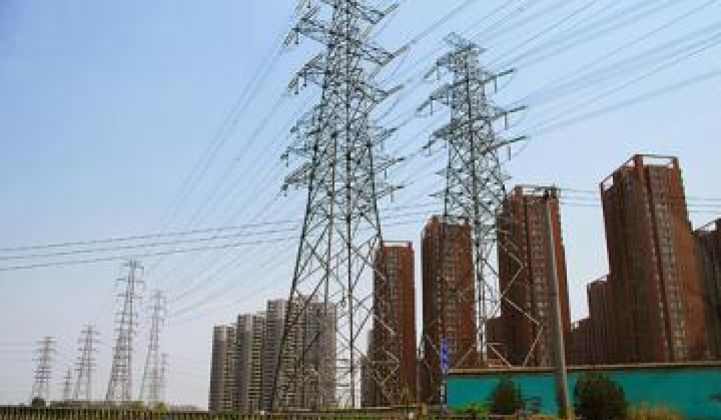After years of predictions that China will take the lead from the United States on smart grid investment, it appears that the moment has arrived.
That’s according to Bloomberg New Energy Finance, which reported Tuesday that China invested $4.3 billion on smart grid in 2013, far outpacing U.S. spending of $3.6 billion in the same period.
What’s more, China’s smart grid spending grew in 2013, while U.S. spending fell by nearly one-third compared to the previous year, BNEF reported. That makes China by far the single largest smart grid spender in 2013, accounting for more than a quarter of the worldwide smart grid spending of $14.9 billion last year, up from $14.2 billion in 2012.
Roughly half of this spending is on smart meters, with the remaining half on distribution automation and other projects. That side of the smart grid equation actually saw stronger growth in 2013 than did smart metering: distribution automation spending increased to $5.4 billion from $4.4 billion in 2012, BNEF noted.
As Rick Thompson, Greentech Media president and co-founder, noted, "Our long-term view for U.S. smart grid spending, and internationally, for that matter, is that it will largely follow distributed generation deployment at the grid’s edge, to improve reliability, power quality and a shift toward a decentralized architecture." On that front, focusing too much on smart meter deployments will not capture the smart grid sectors with the largest potential for growth over the remainder of the decade, he noted.
China continues to invest heavily in new transmission lines and substations to incorporate its growing share of far-off wind and solar power into its grid. But it was on the smart meter front that the country’s spending really took off last year. In fact, China’s massive investment now puts it on track for having 250 million smart meters installed at the end of last year -- more than twice the total number of U.S. households, and far above the roughly 46 million smart meters installed in the U.S. as of mid-2013, though that number continues to grow as well.
And, while analysts including BNEF and GTM Research have been tracking the decline in North American smart meter deployments as billions of federal stimulus dollars have been spent, China is putting policies in place to bring smart meters to 95 percent of households by 2017. China has about 1.34 billion people and 402 million households according to its 2010 census, meaning there’s a lot more room to grow.
For State Grid Corporation of China (SGCC), the utility that serves about four-fifths of the country, that metering market could add up to 50 billion yuan ($7.7 billion) for meters and another 70 billion yuan ($11.6 billion) in related equipment and software, according to a 2011 report from China Daily. As Greentech's Thompson noted, "Given China’s sheer size, in terms of geography and population, it’s not surprising, especially in light of the fact that younger generations are affording themselves western-style luxuries that are consuming electric power at unprecedented levels across the country."
Even so, China’s smart meter landscape will look a lot different than those we’re seeing emerge in the United States, Europe, Japan and other developed economies. First, China is demanding much cheaper meters, about $50 apiece or less for mass-market residential units, compared to the $150 and up for North American smart meters and the $100 and up common for European smart meter projects.
Second, many of the multi-million-meter deployments that BNEF and other researchers are counting in China may not be fully functional yet. According to industry observers, China is starting first by deploying meters that are capable of two-way digital communications, but not yet turned on. Only later will these millions of meters be networked and managed by the back-office software to bring their full functionality into play.
All these factors could make room for non-Chinese smart meter technology, grid networking and software vendors trying to break into a market that’s likely to be dominated by domestic meter makers. ResearchInChina reported that the country’s top three companies, Wasion Group, Linyang Electronics, and Ningbo Sanxing, hold less than 6 percent market share at present.
Meanwhile, joint ventures such as Echelon’s work with China’s Holley Metering and eMeter and Siemens’ partnership with Wasion are making inroads into Chinese smart meter projects. Itron, Toshiba’s Landis+Gyr, General Electric and Silver Spring Networks are all working on Asian projects with an eye toward getting a piece of China’s market.
European and North American powerline carrier (PLC) technology vendors like Qualcomm and STMicroelectronics are contending with Chinese PLC providers such as Miartech, and Cisco Systems was demonstrating how its has integrated its IPv6 grid networks into several Chinese smart meter brands at last month’s DistribuTECH conference in San Antonio, Texas.



